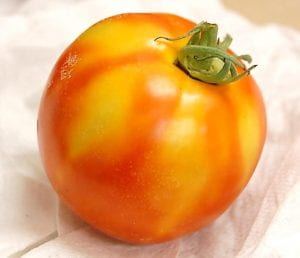Jerry Brust, IPM Vegetable Specialist, University of Maryland; jbrust@umd.edu
A very wide spread problem this year in tomatoes, especially some of the large-sized fruit, is yellow shoulders. Yellow shoulders is characterized by areas at the top of the fruit (shoulders of fruit) that stay green or yellow and as the fruit ripens tend to turn a more intense yellow. These areas will never ripen properly. The area beneath the yellow shoulders is firm and poor tasting. Unfortunately the cause of this problem is complex involving the environment and plant physiology and there is no cure, but there are things that can be done to ease the symptoms. One of the main causes is one we have had lots of and one we can’t do much about and that is intense heat (this past July was the hottest month on record for our area). High temperatures prevent lycopene production (red pigment of the tomato fruit) most often in the shoulders of tomato, as this part is more commonly exposed to the direct rays of the sun. We measured fruit (pulp) temperatures of between 86o and 105oF morning through evening hours in July. When temperatures are greater than 85-88oF lycopene is not produced. Temperatures need to drop below 85oF before it is consistently produced.
Inside the plant we see a reduction in potassium (K) just before yellow shoulders is seen. This year in our tissue testing we saw drops in K of 3-4% in a matter of weeks going from 4-6% (which is good) to 2-3% (which is poor). Usually within a week or two of this drop we see yellow shoulders start up. There are also drops in calcium (Ca), nitrogen and at times magnesium (Mg) as we move into mid-July and early August. All this is related to stress on a plant that has a full fruit load and the stress could be too little water, too much heat (most common), or high amounts of plant disease or insect problems. We see the same problems in high tunnels; only we see them a month earlier than in the field. For now, best recommendations are to add more potassium and calcium to plants and make sure plants are well watered. You can add either nutrient through the drip or as foliar sprays. Foliar sprays will help, but it is difficult to raise the potassium levels 2-4% points as would be needed. I have found that boron also plays a role in helping with the uptake of K, Ca, sulfur and Mg, but all the data are not in at this time to make a recommendation. Yellow shoulders is also a varietal problem, as some varieties are more prone to the problem than others. One unusual way of avoiding the problem all together is to harvest tomatoes when pink color is first seen and let the fruit ripen at room temperature in the dark. Because the lycopene is produced as the fruit ripens it is often possible to avoid yellow shoulders by removing the fruit from the high temperatures and other stresses.
Various forms of yellow shoulders on red tomato fruit




